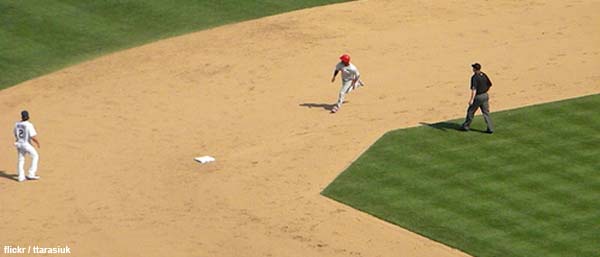Baseball Science: Perfect Baserunning Path Revealed


The shortest distance between two points is a line, most mathematicians will tell you. But researchers at Williams College have shown that upon hitting a potential double or a triple, baseball players would be wise to take a curved path.
Ballplayers intuitively know this, but the new study offers precise suggestions for the optimal angles to take, and it suggests that baserunners ought to start the cuve right off the bat, but most often they don't.
By cutting off the corners, an average runner can round the bases 20 percent faster than one who might try taking a straight path from base to base, the new calculations show.
"If you hit that ball and you know you're going to go farther than first base, you shouldn't run straight for first base," said Frank Morgan, professor of mathematics at Williams College. "Right from the beginning, you should head to the right, 25 degrees off to toward the dugout, right from the base path to the outside. Don't wait. Do it right away."
The approach is within the rules for Major League Baseball, the researchers say.
If there's a potential triple in the offing, then as the runner rounds first, he should continue the curve as he heads to second base. For a possible in-the-park homer, he should then bulge out even further between second and third so he's is lined up to make the straight sprint home, Morgan said.
In real life, often a runner begins by heading straight to first base as the ball leaves the bat. Only partway down the baseline will he begin to veer right if he think's extra bases are possible.
Get the world’s most fascinating discoveries delivered straight to your inbox.
"By the time you're done curving to the right and then curving back to the left ... you've wasted a lot of energy and time and distance," said co-researcher Stewart Johnson. "It's much better to start out running angled off to the right and run around first base in one smooth arching curve."
Using the "veer to the right just before the base" approach, a typical player will take 22.2 seconds to complete an in-the-park home run. That same player using the optimal strategy of a constantly curving path can round the bases in 16.7 seconds.
"I don't think you're ever going to convince a baseball player that if you hit the ball, his first couple of steps should be away from the field of play toward his own dugout," said co-researcher Davide Carozza. "But it would be cool to see someone actually test it out."
The science of baseball is getting sharper, meanwhile.
- Scientists have shown that head-first slides are best.
- They've found that keeping your eye on the ball is not always the best way to hit.
- A study revealed that a batting-average bubble in the late 1990s was caused by umpires, not steroids.
- And studies show that the best hitters actually see a bigger ball than other batters do.
- By moving, outfielders are better able to predict a fly ball's path, rather than standing and waiting for it.
Morgan wonders if the big leagues will test out his group's new study.
"We haven't heard from the major leagues yet, but I don't see why they shouldn't give this more attention," said Morgan. "We'll see what happens. By the next World Series, maybe they'll let me in the booth there with them. Sometimes, math takes thousands of years to catch on. I'm in no hurry."
Robert is an independent health and science journalist and writer based in Phoenix, Arizona. He is a former editor-in-chief of Live Science with over 20 years of experience as a reporter and editor. He has worked on websites such as Space.com and Tom's Guide, and is a contributor on Medium, covering how we age and how to optimize the mind and body through time. He has a journalism degree from Humboldt State University in California.

